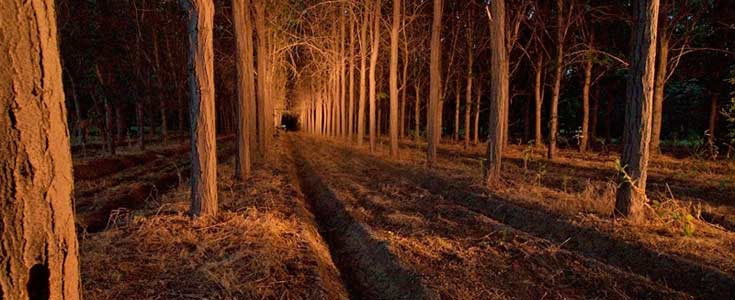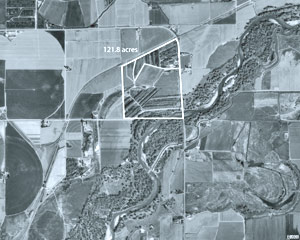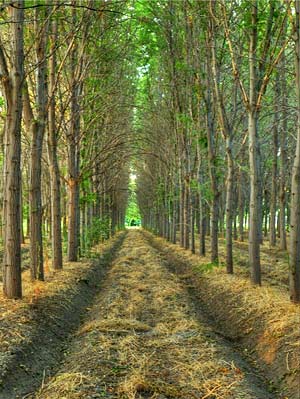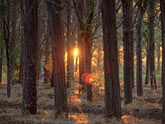

Photograph © Jay Dickman
This orderly forest, located 50 miles north of Denver and flanked on the west by the Rocky Mountains, is inhabited by wild turkey, deer, and a diverse variety of birds. In fact, it actually is a 150-acre tree farm whose dense canopy is an anomaly amongst the predominantly grassy plains. Along with the South Platte River, it fosters unique ecological stimulation in the region. However, suburban growth is quickly overtaking farmland in the area and, while the current owner hopes to encourage development of the site to include the forest, potential developers would prefer to raze the trees and work with a “blank” site.
History


(top) Aerial photograph with boundary of tree farm
highlighted.
(bottom) Photograph © Jay Dickman
Jane and Gene Kammerzell established Arborland Nursery in 1971 by gradually converting their family farm into a horticultural enterprise. For the first few years, the nursery consisted of a small garden center that included a greenhouse and growing beds. The trees were sold locally to retail buyers along with landscape services. As the business expanded, the Kammerzells began to grow field trees and, by the late 1970s, Arborland was home to nearly 5000 2-inch in diameter trees that were being harvested for both retail and wholesale distribution throughout the region.
During the following two decades, the work at Arborland shifted away from growing smaller trees and was directed toward larger 3- to 6-inch diameter trees for the commercial landscape trade. This move led to requests for even larger trees to fill an emerging market supplying developers of large estates. By the 1990s, Arborland was growing 6-to 8-inch trees and had expanded inventory to include 12,600 large trees on 90 acres. Today, the collection consists of a mixture of conifers and shade and ornamental trees such as honeylocust, ash, white oaks, silver maples, crabapples, hawthorns, Austrian pine, scotch pine, Colorado blue spruce, and Black Hills spruce.
The diversity and size of the collection as well as the size of the individual trees made Arborland’s canopy an anommally in the area of largely grassy plains. Wild turkeys were brought in for natural grasshopper control in the garden, while the new “forest” initiated unprecedented ecological stimulation in the area, becoming an oasis for deer, birds, and a variety of other wildlife. Moreover, the presence of the South Platte River, a major and significant riparian feature of the area, encouraged the animals’ settlement in the manmade forest.
In 2003, a developer from nearby Fort Collins became interested in the property due to the large trees and central location in northeastern Colorado. The developer sought to create a forested community on 122 acres that would appeal to those seeking limited upscale development. However, before the sale could be finalized, an oil company with drilling rights on the farm (Union Pacific Rail Road, which owns the property’s mineral rights) notified the owners of an oil spill on the property. The spill took several years to clean up, and the developer lost interest in the project.
Threat
Photo by Brian Cook
The Kammerzells continue to operate the garden center and care for the nursery; however, the commercial aspect has been downsized as the couple nears retirement. The most immediate threat to the forest is a lack of awareness of the property significance. Suncor Energy, which has a Right-of-Way agreement, recently cut down a significant number of trees in order to allow aerial inspection of their pipeline as it runs beneath the fields. Moreover, large new retail outlets and medical facilities have sprung up nearby, attracting more and more people to the area and closing the gaps between the region’s cities. Colorado Highway 60, which borders the farm on the east, is charted for expansion to accommodate the growing number of commuters from Greeley and Fort Collins to Denver, which also could lead to the removal of hundreds of trees.


